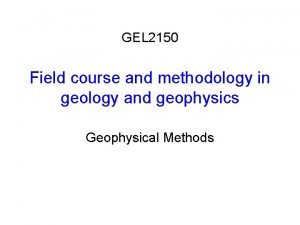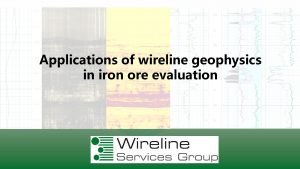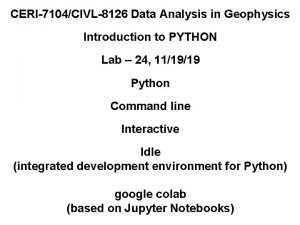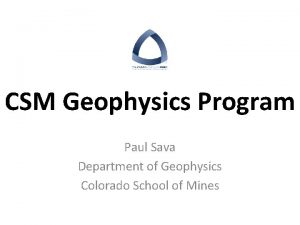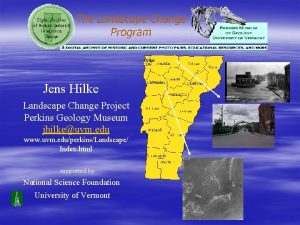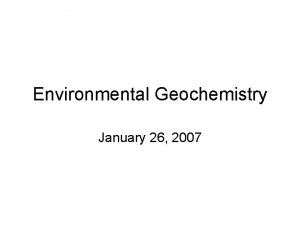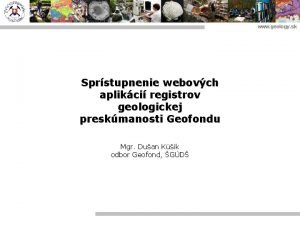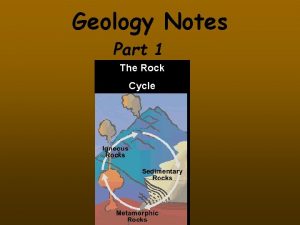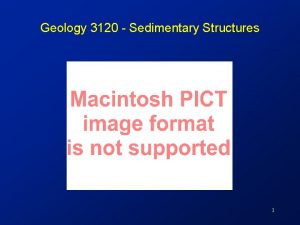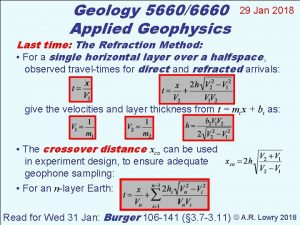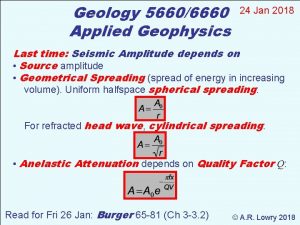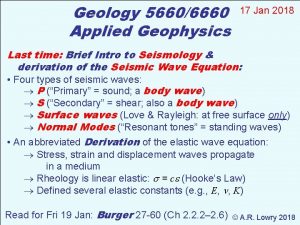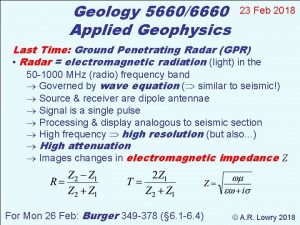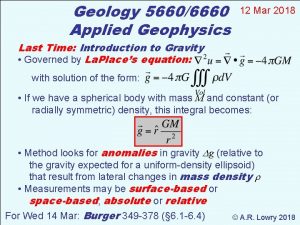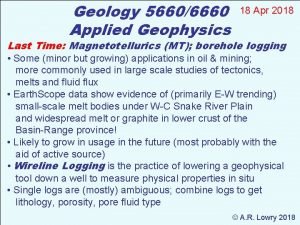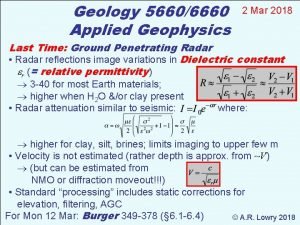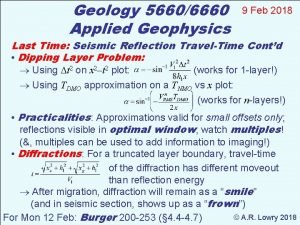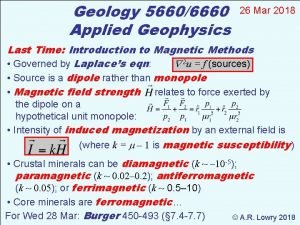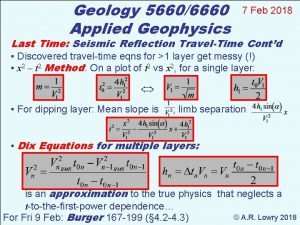Geology 56606660 Applied Geophysics 19 Jan 2018 Last














- Slides: 14

Geology 5660/6660 Applied Geophysics 19 Jan 2018 Last time: Seismic velocity & Instrumentation: • Velocities are more sensitive to & than to ; depend on porosity, lithology, cementation, pressure, temperature, fluids • A seismometer (or geophone) is an inertial mass that moves relative to a frame, coupled to the ground • Mass = magnet (or coil) moves wrt coil (or magnet); Voltages are amplified and recorded as signal. • Motions damped to maximize signal & minimize “ringing” Useful Concepts: Time & Frequency Domains • Time-dependent signals (time domain) can be expressed as amplitudes of sum of sin( ) & cos( ) for all (frequency domain). • A Seismogram is t-domain convolution ( -domain multiplication) of source, Earth response, instr. response For Mon 22 Jan: Burger 27 -60 (Ch 2. 2. 2– 2. 6) © A. R. Lowry 2018

(Note: for really big signals, can get more robust operation and lower frequencies from other types of instruments… E. g. GPS!) 4 April 2010 M 7. 2 Baja California earthquake

(Note: for really big signals, can get lower frequencies from other types of instruments… E. g. GPS!) GPS Displacement Seismometer Displacement 10 August 2009 M 7. 6 earthquake north of Andaman

Huygen’s Principle: Every point on a wavefront can be treated as a point source for the next generation of wavelets. The wavefront at a time t later is a surface tangent to the furthest point on each of these wavelets. We’ve seen this before… This is useful because the extremal points have the greatest constructive interference

Fermat’s Principle (or the principle of least time): The propagation path (or raypath) between any two points is that for which the travel-time is the least of all possible paths. Recall that a ray is normal to a wavefront at any given time: A key principle because most of our applications will involve a localized source and observation at a point (seismometer).

Fermat’s principle leads to Snell’s Law: Travel-time is minimized when the ratio of sines of the angle of incidence (angle from the normal) to a velocity boundary is equal to the ratio of the velocities, i. e. , V = fast V = slow • least time in slow time t s a le e • lin t h raig st least time in fast

NOTE that much of the wave theory that applies to seismology also applies to optics (a wave phenomenon also)… Aboriginal spear-fishers understand Snell’s law intuitively, after learning to always aim below the visual location of the fish!


Reflections & Refractions: Consider that when a seismic wave meets a layer boundary between media with different velocities V = f = /T, ( = 2 f • Energy E must be conserved = 2 /T!) • Stress must be continuous (i. e. the same on both sides) • Displacement u must be continuous This is achieved by “partitioning” the energy between reflections & refractions, and in many cases by converting part of the energy from one type of wave to the other! ref l ec te refle d. P cted inc ing m o S P ed P t c a refr S refracted

Reflections & Refractions: All of the reflected and refracted waves must obey Snell’s Law. Consequently, • A reflected wave (traveling at the same velocity) will have the same angle of incidence as the incoming wave. • A reflected or refracted wave traveling at faster velocity will be bent toward the layer boundary • A reflected or refracted wave traveling at slower velocity will be bent toward the normal to the boundary. ref l ec te refle d. P cted inc ng i om S P ted c a r f re S refracted P

Consider the “idealized” scenario of a source at the surface producing seismic waves that traverse a horizontal boundary between two layers (slower upper & faster lower): c There will always be some angle of incidence for which the angle of the refracted ray is parallel to the layer boundary. Rays arriving at angles > this critical angle will not transmit refracted energy into the lower layer (only reflections or conversions). The critical angle, c, is given by: or

From Huygen’s Principle can also predict diffractions, waves that don’t fit the ray-theory approximation: These waves are always there but not generally observed unless for some reason part of the destructively interfering wavefield is removed… Diffractions commonly result when a structure is “non-ideal”, e. g. when it is discontinuous or compact.

Some basic concepts of seismic amplitude: Impedance Contrast: Thus far we’ve focused much of the discussion on concepts related to velocity & travel-time, but seismic waves also have amplitude, A, of the particle displacements: Amplitudes of reflections & refractions are determined by energy partitioning at the boundary. A normally-incident ( = 0) P-wave with amplitude Ai produces a reflected P with amplitude: P A ng i (reflection om c n i coefficient) (refraction and a refracted P: coefficient) where Zi = i. Vi is the impedance in layer i

Important to note: 1. Many seismology methods focus on travel-time & hence are parameterized by velocity (e. g. , tomography, the refraction method, …). Reflection seismic uses amplitude so responds to impedance! 2. The relations for reflection get much more complicated when 0. We will talk more about Zoeppritz’ equations for the non-trivial case later…
 Gel geophysics
Gel geophysics Wireline geophysics
Wireline geophysics Python for geophysics
Python for geophysics Csm geophysics
Csm geophysics Jan 31 2018
Jan 31 2018 January 2018 chemistry regents answers
January 2018 chemistry regents answers Que letra continua m v t m j
Que letra continua m v t m j Uvm landscape change
Uvm landscape change What is geochemistry in geology
What is geochemistry in geology Www.geology.sk
Www.geology.sk Wjec a level geology
Wjec a level geology Quarttzite
Quarttzite Earth science vs geology
Earth science vs geology Graded bedding
Graded bedding Geology lecture series
Geology lecture series
